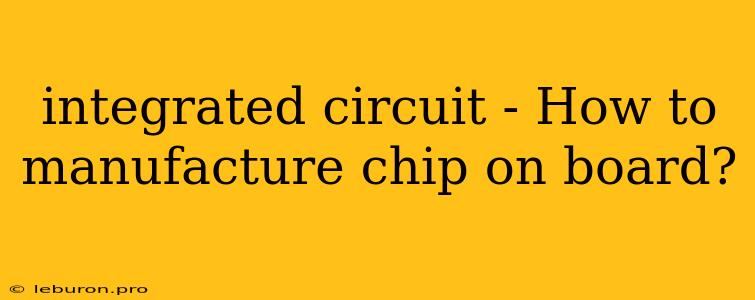The world runs on integrated circuits, or chips, the tiny brains that power everything from smartphones to satellites. But how do these complex pieces of technology come to life? One method, known as chip-on-board (COB) manufacturing, offers a unique and efficient way to create integrated circuits for specific applications. COB technology allows manufacturers to directly mount a bare die, the heart of the integrated circuit, onto a printed circuit board (PCB). This process eliminates the need for traditional packaging, resulting in a smaller, more compact, and often more cost-effective solution. This article delves into the intricacies of COB manufacturing, exploring the steps involved, its advantages and disadvantages, and the diverse applications where it shines.
Understanding Chip-on-Board (COB) Manufacturing
Chip-on-board (COB) manufacturing is a crucial step in the creation of integrated circuits. This method involves directly mounting a bare die, the active semiconductor component, onto a printed circuit board (PCB) without any additional packaging. Unlike traditional packaging, where the die is enclosed in a protective casing, COB technology exposes the die directly, allowing for a more compact and efficient design. This direct mounting is achieved through a series of meticulous steps:
Step 1: Die Preparation and Screening
Before mounting the die, it undergoes a thorough preparation process. This includes cleaning the die to remove any contaminants and applying a protective layer to enhance its reliability. The die is then screened to ensure it meets specific quality standards and functions correctly.
Step 2: PCB Preparation and Screening
The PCB, the foundation for the integrated circuit, is also meticulously prepared. This involves cleaning the surface to ensure proper adhesion of the die. The PCB may undergo a screen printing process to apply conductive paste, creating pathways for electrical connections.
Step 3: Die Bonding and Wire Bonding
The heart of the COB process is the die bonding step, where the prepared die is carefully placed onto the prepared PCB. This is typically achieved using an epoxy adhesive that secures the die in place. After bonding, fine gold wires are used to establish electrical connections between the die and the PCB, ensuring proper signal transmission.
Step 4: Encapsulation and Testing
To protect the delicate die and its connections, the COB assembly is encapsulated with a protective resin or conformal coating. This step shields the integrated circuit from moisture, dust, and other environmental factors, enhancing its durability and reliability. Finally, the completed COB assembly undergoes rigorous testing to ensure it meets all performance and quality standards.
Advantages of Chip-on-Board (COB) Technology
COB technology offers numerous advantages, making it a popular choice for a wide range of applications:
- Compact Size: COB assemblies are significantly smaller than traditional packaged integrated circuits, allowing for more compact and space-saving designs.
- Improved Thermal Performance: The direct mounting of the die on the PCB enhances heat dissipation, improving the thermal performance of the integrated circuit.
- Cost-Effectiveness: By eliminating traditional packaging and associated processes, COB manufacturing can be more cost-effective than traditional methods, particularly for high-volume production.
- Increased Reliability: The encapsulation of the COB assembly protects the die from environmental hazards, leading to enhanced reliability.
- Flexibility in Design: COB technology offers flexibility in designing the circuit, allowing for customized layouts and integration of different components on the PCB.
Disadvantages of Chip-on-Board (COB) Technology
While COB technology offers many benefits, it also has some limitations:
- Limited I/O Count: The direct mounting of the die limits the number of input/output (I/O) pins that can be accessed, which can pose a challenge for complex circuits with extensive I/O requirements.
- Increased Complexity: COB manufacturing involves more intricate processes than traditional packaging, requiring specialized equipment and skilled technicians.
- Limited Reprogrammability: Once encapsulated, the COB assembly is not easily reprogrammable, which may not be suitable for applications requiring frequent reconfiguration.
- Potential for Die Damage: The exposed die in a COB assembly is more susceptible to damage during handling and manufacturing.
- Limited Customization: While COB technology offers flexibility, it may not be the best choice for applications requiring highly customized packaging or specialized features.
Applications of Chip-on-Board (COB) Technology
The unique characteristics of COB technology make it well-suited for various applications:
- Consumer Electronics: COB is widely used in consumer electronics, such as smartphones, tablets, and wearable devices, where compact size, low cost, and high performance are crucial.
- Automotive Industry: The robust nature and thermal performance of COB technology are advantageous in automotive applications, such as engine control units, sensors, and lighting systems.
- Industrial Automation: COB assemblies are used in industrial automation systems, such as robotics, control systems, and sensors, due to their reliability and compactness.
- Medical Devices: The small size and high performance of COB technology are particularly well-suited for medical devices, including pacemakers, insulin pumps, and implantable sensors.
- Aerospace and Defense: COB technology finds application in aerospace and defense systems, where compact size, reliability, and resistance to environmental factors are critical.
Future of Chip-on-Board (COB) Technology
COB technology is expected to continue evolving and gaining popularity in the future. Advancements in manufacturing processes, materials, and encapsulation techniques will lead to further improvements in performance, reliability, and cost-effectiveness.
As miniaturization trends continue to drive the demand for smaller and more efficient integrated circuits, COB technology will play an increasingly important role in shaping the future of electronics. With its compact size, high performance, and cost-effectiveness, COB technology offers a compelling solution for a wide range of applications, continuing to drive innovation across diverse industries.
